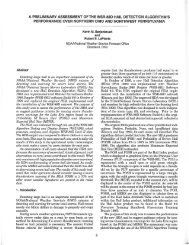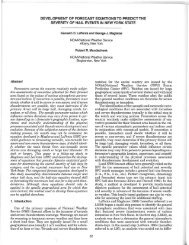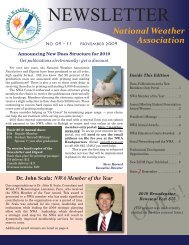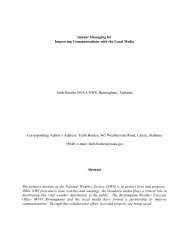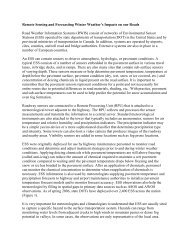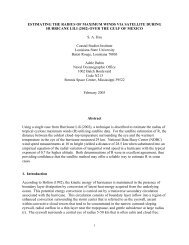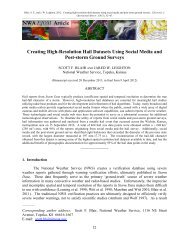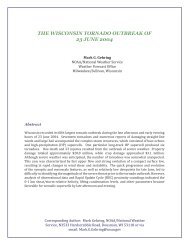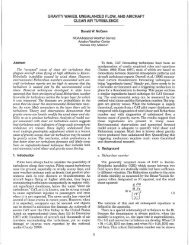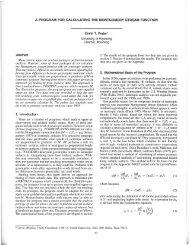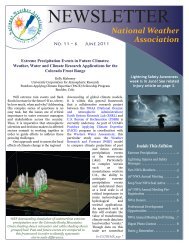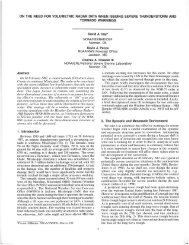Using WSR-88D reflectivity data for the prediction of cloud-to-ground ...
Using WSR-88D reflectivity data for the prediction of cloud-to-ground ...
Using WSR-88D reflectivity data for the prediction of cloud-to-ground ...
You also want an ePaper? Increase the reach of your titles
YUMPU automatically turns print PDFs into web optimized ePapers that Google loves.
Volume 27 December 2003<br />
41<br />
Fig. 5. Representative vertical cross-sections <strong>of</strong> radar <strong>reflectivity</strong><br />
(d8Z, shaded) <strong>for</strong> examples <strong>of</strong> false alarms (heights in kft). Heights<br />
<strong>of</strong> <strong>the</strong> -1 DOG and -15°G iso<strong>the</strong>rms are shown.<br />
ferences that were found in <strong>the</strong> analysis <strong>of</strong> archived <strong>data</strong><br />
in WATADS were consistent with those found in past<br />
studies (e.g., Shack<strong>for</strong>d 1960; Zipser and Lutz 1994).<br />
Zipser and Lutz (1994) found that convective cells over<br />
<strong>the</strong> tropical ocean that did not produce CG lightning contained<br />
large negative vertical gradients <strong>of</strong> <strong>reflectivity</strong> in<br />
<strong>the</strong> O°C <strong>to</strong> -20°C temperature range, a direct result <strong>of</strong><br />
weaker vertical velocities. They concluded that, as a necessary<br />
condition <strong>for</strong> rapid electrification, a convective cell<br />
must have its updraft speed exceed some threshold value<br />
(6-7 m S·I mean speed and 10-12 m S-I peak speed). In this<br />
study, <strong>the</strong> <strong>reflectivity</strong> structure <strong>of</strong> a convective cell that<br />
did not produce lightning was organized such that <strong>the</strong><br />
center <strong>of</strong> highest <strong>reflectivity</strong> (on <strong>the</strong> order <strong>of</strong> 40-45 dBZ)<br />
was just below <strong>the</strong> height <strong>of</strong> -lOoC and -15°C (Fig. 5). A<br />
convective cell organized in such a fashion usually just<br />
met <strong>the</strong> criteria <strong>for</strong> a lightning producing cell but did not<br />
produce lightning. The <strong>reflectivity</strong> structure <strong>of</strong> a convective<br />
cell that produced lightning generally contained a<br />
Fig. 6. Same as in Fig. 5, except <strong>for</strong> examples <strong>of</strong> detections.<br />
strong (45-50+ dBZ) echo that vertically extended well<br />
above <strong>the</strong> -lOoC and -15°C heights (Fig. 6). The <strong>reflectivity</strong><br />
gradients between <strong>the</strong> O°C <strong>to</strong> -lOoC, O°C <strong>to</strong> -15°C,<br />
and O°C <strong>to</strong> -20°C iso<strong>the</strong>rm heights were analyzed <strong>for</strong><br />
eight different cases (four detections and four false<br />
alarms). These eight different cases were chosen at random,<br />
with four cases coming from a dominant false alarm<br />
day and four cases coming from a dominant detection<br />
day. The results <strong>of</strong> <strong>the</strong> <strong>reflectivity</strong> gradient analysis are<br />
shown in Table 6.<br />
Looking at Table 6, it is apparent that <strong>the</strong> false alarms<br />
cases had larger negative lapse rates in comparison with<br />
<strong>the</strong> detection cases. The mean <strong>reflectivity</strong> lapse rate<br />
between <strong>the</strong> O°C and -20°C <strong>for</strong> a false alarm was -2.04<br />
dBZ/k:ft; and <strong>the</strong> mean <strong>reflectivity</strong> lapse rate between O°C<br />
and -20°C <strong>for</strong> a detection was -0.69 dBZ/k:ft;. Although<br />
<strong>the</strong>re are a few outliers, <strong>the</strong> bulk <strong>of</strong> <strong>the</strong> <strong>data</strong> upholds <strong>the</strong><br />
trends described above. Large negative lapse rates (-2.00<br />
dBZ/k:ft; or less) between <strong>the</strong> analyzed iso<strong>the</strong>rm heights<br />
would suggest that <strong>the</strong> echo centroid <strong>of</strong> highest reflectiv-



